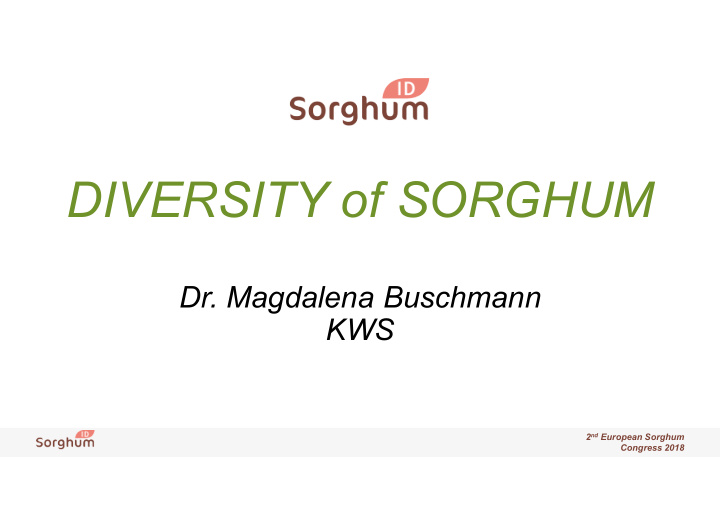



DIVERSITY of SORGHUM Dr. Magdalena Buschmann KWS 2 nd European Sorghum Congress 2018
SORGHUM ORIGIN Sorghum is from the family POACEAE Sorghum has it’s origin in Northeastern Africa as a wild plant Earliest known record of sorghum comes from Egyptian-Sudanese border and had been dated at 8.000 B.C. Sorghum belt is between 40 degrees North and 40 degrees South of the equator, in warm and hot countries characteristic for semi arid environment Sorghum is usually grown in areas that are too hot and dry for maize Over 50% of World sorghum varieties are hybrid, the lowest concentration of hybrid varieties is in Africa Hybrid production system is CMS 2nd European Sorghum Congress 2018
SORGHUM CLASSIFICATIONS Botanical classification Classification according usage What do we see in the picture? Source: KWS 2nd European Sorghum Congress 2018
SORGHUM TAXONOMY Sorghum ( Sorghum bicolor L. Moench) a tropical grass grown primarily in semiarid parts of the world, particularly in Africa, India and Asia, where it is an important staple food crop. It is a member of the family Poaceae and the tribe Andropogoneae, of which there are three main species: S. bicolor - diploid (2n=20) all annual and domesticated types, including stabilized weedy derivatives such as Sudangrass. Widely distributed. S. halepense - Johnsongrass. Tetraploid, native perennial of southern Eurasia, east to India. S. propinquum - Diploid, native perennial of Sri Lanka and southern Source:Cirad India. 2nd European Sorghum Congress 2018
BOTANICAL RACES OF CULTIVATED RACES OF S. BICOLOR SSP BICOLOR II. Intermediate races: (all combinations of I. Basic races: basic races) bicolor (B) guinea-bicolor (GB) guinea (G) - Sudanian area caudatum-bicolor (CB) caudatum (C) – Eastern Africa kafir-bicolor (KB) kafir (K) – South Africa, mainly short durra-bicolor (DB) plants guinea-caudatum (GC) durra (D) - East Africa, Middle East and guinea-kafir (GK) India guinea-durra (GD) kafir-caudatum (KC) durra-caudatum (DC) kafir-durra (KD) 2nd European Sorghum Congress 2018
BOTANICAL RACES OF WILD SORGHUM (SORGHUM BICOLOR SSP VERTICILLIFLORUM) III. Wild sorghum races: S. bicolor ssp arundinaceum . arundinaceum aethiopicum virgatum verticilliflorum (courtesy of J Hancock: Plant Evolution and the Origin of Crop Species; art work by Marlene Cameron) 2nd European Sorghum Congress 2018
RACES OF SORGHUM BICOLOR - PANICLE TYPES Source: KWS 2nd European Sorghum Congress 2018
TAXONOMY OF SORGHUM TYPES USED IN AGRICULTURE Sorghum sudanense S. bicolor x S. sudanense S. bicolor ssp. bicolor S. bicolor ssp. bicolor Sorghum bicolor x Sorghum sudanense Sorghum bicolor x Sorghum Bicolor slight tillering type with diverse directions of usage: Sugar type Forage type for silage BMR Grain type Source: KWS 2nd European Sorghum Congress 2018
SORGHUM PANICLE TYPES - OPENESS 2nd European Sorghum Congress 2018
MAIN TRAITS OF BICOLOR TYPE Almost no tillering Broad leaves Robust stem Lower sowing density Differences also according genetic origin or variety type Closed panicles = Potentially of high sugar content Broomcorn panicles = high yield potential and high lignin content Kaoliang = good cold tolerance and earliness Sorghum Bicolor x Sorghum Bicolor Source: KWS 2nd European Sorghum Congress 2018
MAIN CARACTER OF SUDANENSE TYPES Tillers – depending on type – sudanense pure has more tillers than crossing with Bicolor thin leaves thin stem Higher sowing density Weak to normal standability Weaker yield potential Earliness Good cold tolerance Sorghum Bicolor x Sorghum Sudanense Source: KWS 2nd European Sorghum Congress 2018
SEGMENTATION ACCORDING USAGE BIOMASS SORGHUM SWEET SORGHUM FORAGE SORGHUM Source: http://grao.cnpms.embrapa.br Source: http://www.heritageseeds.com.au Source: KWS, Buschmann DUAL TYPES SORGHUM MULTICUT SORGHUM GRAIN SORGHUM Source: http://oklahoma4h.okstate.edu Source: KWS, Buschmann Source:BBF Project 2nd European Sorghum Congress 2018
UTILISATION OF SORGHUM NON GRAIN TYPES Biomass sorghum (including dual types) Biogas plants Energy Combustion plants Energy Feed Broom sorghum Forage sorghum (including BMR types) Feed as fresh forage Feed as hay Multicut Sorghum PPS Sorghum Sweet sorghum Feed Bioethanol productions Source: http://sirak.rs/hu/ciroksepru-forgalmazasa Source:Cirad Sweeteners (Syrup, molasse, sugar) 2nd European Sorghum Congress 2018
BMR TYPE OF SORHUM High sugar content main markers Lower Lignin content (about 40- 60 % of normal biomass sorghum) Lower standability High digestibility High methane formation Source: KWS 2nd European Sorghum Congress 2018
UTILISATION OF SORGHUM GRAIN TYPES Grain sorghum Feed Food Tanin containing sorghum - alcohol production – e.g. Baijiu in China or beer Tanin free sorghum - dry milling products and non gluten food products e.g. bread, flakes, pasta, puffs, crisps and chips Bioethanol production Source: https://nulifemarket.com Source: https://nulifemarket.com 2nd European Sorghum Congress 2018
Thank you for your attention! 2 nd European Sorghum Congress 2018
Recommend
More recommend